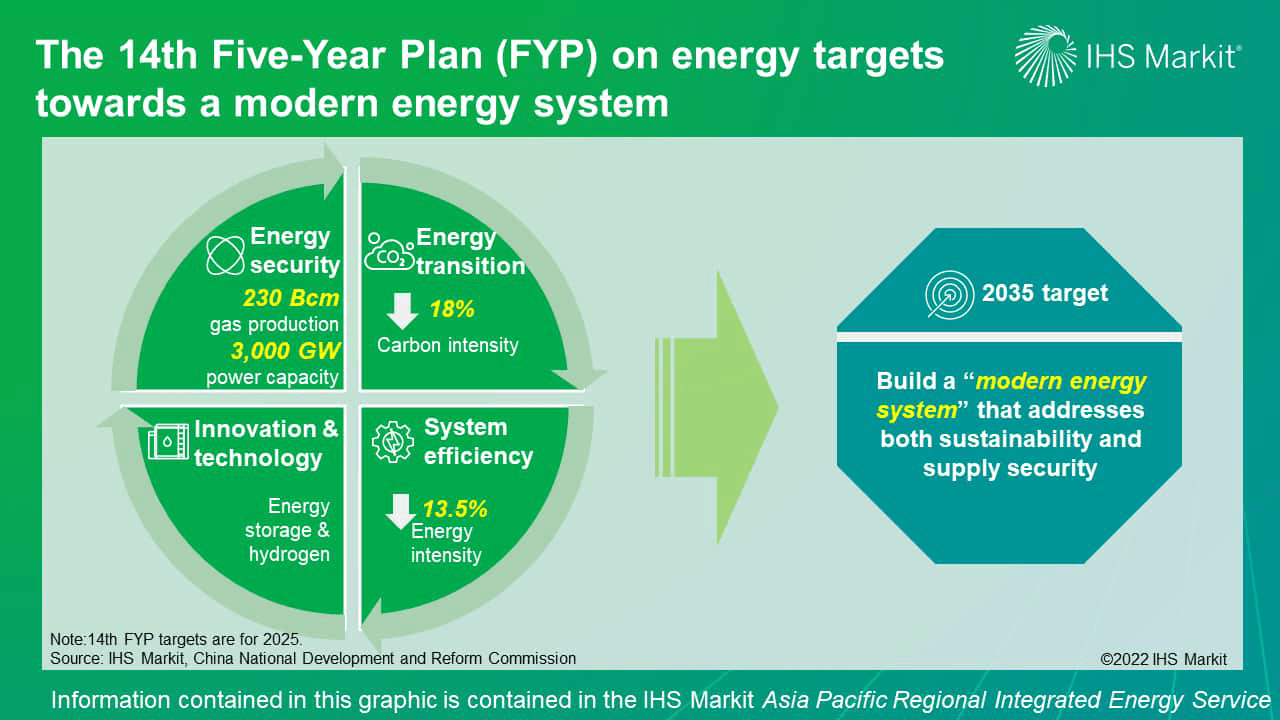peterschreiber.media/iStock via Getty Images
On 22 March 2022, China released the 14th Five-Year Plan (FYP) for the energy sector, covering development plan through 2025. As the first energy-specific FYP released following China’s carbon pledges, the policy pivots China’s energy sector toward the long-term transition goals and the establishment of a modern energy system that addresses both sustainability and supply security issues. Although the policy does not include many new quantitative targets, it reaffirms the recent policy direction and provides more clarity on the short-term approach and measures.
The 14th FYP discloses key 2025 objectives in four categories – supply security, system transition, efficiency, and innovation – to guide the energy sector toward the modern energy system. Contrary to the focus in the 13th FYP on air pollution control, the 14th FYP emphasizes on climate commitment and the energy transition, reflected by the released targets on the primary energy mix, flexible power sources, the electrification rate, and new technologies. These targets, qualitative or quantitative, were never a part of key objectives of China’s FYPs before, though some of them, such as non-fossil fuel share, energy intensity, and carbon intensity goals, have been published in other policies previously.

Renewables additions and system balancing capability will remain the key focus in China’s energy transition. Despite a lack of specific wind and solar capacity targets, IHS Markit expects that strong policy support will lead capacity additions of renewables during the 14th FYP to be 50% higher than the annual average during the 13th FYP period. To accommodate the growth of renewables, the policy unprecedentedly emphasizes the balancing capacity of the power system, with new targets assigned to pumped hydro, demand response, and coal retrofits. As a peaking source, gas will develop “where local circumstances permit,” given fuel cost and availability considerations.
Supply security will hold higher priority than in the previous FYP. As a result, coal and coal-fired power reductions will take a more cautious pace. Shifting from the tone in the 13th FYP, which focused on dealing with overcapacity, the 14th FYP names coal as “the backstop of supply security” and excludes caps on coal consumption and coal-fired power capacity, alleviating the pressure on gas supply. It is clear that the 14th FYP will continue advancing the energy transition, but not at the expense of supply security.
Market reforms will be a key tool to optimize resource allocation to achieve the sustainability and supply security goals. Power reforms will focus on the establishment of market and pricing mechanisms to enable the growth and integration of renewables on an enlarged scope. Gas reforms will increase system efficiency and competition to reduce costs to end users while allowing cost pass-throughs to maintain supply security.
Editor’s Note: The summary bullets for this article were chosen by Seeking Alpha editors.


Be the first to comment